
About Book
The Cannizzaro reaction, named after its discoverer Stanislao Cannizzaro, is a chemical reaction that involves the base-induced disproportionation of two molecules of a non-enolizable aldehyde to give a primary alcohol and a carboxylic acid. Cannizzaro first accomplished this transformation in 1853, when he obtained benzyl alcohol and potassium benzoate from the treatment of benzaldehyde with potash (potassium carbonate). More typically, the reaction would be conducted with sodium hydroxide or potassium hydroxide, giving the sodium or potassium carboxylate salt of the carboxylic-acid product. The reaction involves a nucleophilic acyl substitution on an aldehyde, with the leaving group concurrently attacking another aldehyde in the second step. First, hydroxide attacks a carbonyl. The resulting tetrahedral intermediate then collapses, re-forming the carbonyl and transferring hydride to attack another carbonyl.[4] In the final step of the reaction, the acid and alkoxide ions formed exchange a proton. In the presence of a very high concentration of base, the aldehyde first forms a doubly charged anion from which a hydride ion is transferred to the second molecule of aldehyde to form carboxylate and alkoxide ions. Subsequently, the alkoxide ion acquires a proton from the solvent.




Add Comment